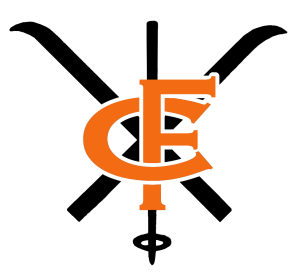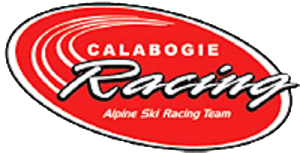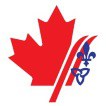The OSZ and NCD are pleased to welcome disabled skiers as participants in K2 races.
Overview
Alpine Disabled Skiing (ADS) is governed by the International Paralympic Committee (IPC) through the International Paralympic Alpine Skiing Committee (IPCAS).
Certain ADS athletes (e.g. single-leg amputees who ski without a prosthesis & sit-ski users) use special poles called outriggers that have short ski blades on the end and help the skier with balance. Other athletes compete from a sitting position using a sit-ski, also called a mono-ski. As the name suggests, mono-skis have a specially fitted chair over a single ski. The chair includes seat belts and other strapping, as well as a suspension device to minimize wear and tear on the skier’s body.
Guides are obligatory for visually impaired athletes and the competitor and his guide are a team. The guide directs the athlete through the course using only voice signals or radio communication to indicate the course to follow.
Athletes compete based on their functional ability, allowing athletes with different disabilities to compete against each other. Alpine skiing includes three main classifications with several sub- categories within each:
Visually impaired
B1 totally blind athletes
B2 visual acuity of 20/60
B3 visual acuity above 20/60 to 6/60
Standing
LW 1 double above knee amputation
LW 2 single above knee amputation
LW 3 double below knee amputation/cerebral palsy
LW 4 single below knee amputation
LW 5/7 double arm amputation
LW 6/8 amputation or other disabilities in one arm
LW 9 one upper limb and one lower limb disability
Sitting
LW 10 no functional sitting balance
LW 11 fair sitting balance
LW 12 paraplegic/amputation of the lower limb/s
Rules
At IPC and other para-alpine events, the Federation International de Ski (FIS) rules are used with modifications set out in the IPC Alpine Skiing Rule Book that is available at www.paralympic.org/release/Winter_Sports/Alpine_Skiing/index.html. These rules have been adapted to support the involvement of para-alpine racers at NCD-OSZ K2 events.
General
Disabled athletes competing in OSZ and NCD K2 or similar alpine events are subject to FIS, ACA and local race rules with these adaptations to accommodate their disabilities.
Eligibility
All athletes participating in NCD and OSZ races must hold an International Paralympic Committee Alpine Skiing (IPCAS) card or be a SQA, AOA or CADS member with general coverage under the Canadian Snow Sports Association insurance program.
Seeding
Disabled athletes will be seeded in a separate group that starts before the K2 females. Within the group, the start orders of the three categories of athletes are:
GS and Speed events: 1. Visually impaired; 2. Sitting; 3. Standing
Slalom events: 1. Visually impaired; 2. Standing; 3. Sitting
First Run: The start order of athletes in each category will be determined by random draw.
Second Run: The start order within each category will be based on the first run results: fastest to slowest. In each category, athletes who are disqualified or did not finish the first run will be seeded last in their category.
Guides
Visually impaired athletes are assisted by guides who precede the racer through the course. The guide starts with the racer from a position beside the start ramp and is required to successfully complete all other gates in the course (i.e. the racer will be DSQ’d if the guide misses a gate.) No physical contact between the guide and competitor is allowed during the race. The distance between guide and athlete in technical events (Slalom and Giant Slalom) must not exceed two direction changes and in speed events (Downhill and Super G) must not exceed one direction change.
Start Rules
The following rules apply at the start:
A standing athlete must put his poles or stabilizers in front of the start line, or where indicated and reach full speed after leaving the start only with the help of poles or stabilizers! The stabilizers or poles must be in a fixed position on the snow before the start.
Sitting athletes require suitable adjustments to the start gate (SEE IPC rules). They are allowed only one push before leaving the start gate — no running start is allowed.
For athletes with a visual impairment:
The guide cannot pass through the starting gate.
The start area should include adequate space for the guide, always in relation to the first gate of the course. The space should be equal to the start position and with the same elevation as the competitor. The start ramp shall be prepared in such a way that the guide can stand relaxed on the starting line and can quickly reach full speed after leaving the start.
Start Intervals
The start can take place in each event at variable intervals determined by chief of timing in consultation with the Jury. With one exception, the competitor on the course does not need to cross the finish before the next competitor starts. The exception is that class B1 athletes must nearly complete the entire course before the next competitor starts.
Recording Finish Time
All FIS finish rules apply for disabled competitors. Note: The guides for visually impaired competitors are required to pass through all gates, including the finish gate, but the competitor‟s time is calculated from his finish time of day (TOD), not the guide‟s. The timer will have to take appropriate steps to ensure that the racer‟s finish TOD time is accurately captured.
Factors
The IPC has established a handicapping (factor) system to calculate results for racers in disabled competitions. The current factor table is available on the International Paralympic Alpine Skiing Committee website: www.paralympic.org/release/Winter_Sports/Alpine_Skiing/index.html.
Further Information: For further information about disabled ski racing contact:
Name: Jamie Rosewarne Email: jrosewarne@sympatico.ca



